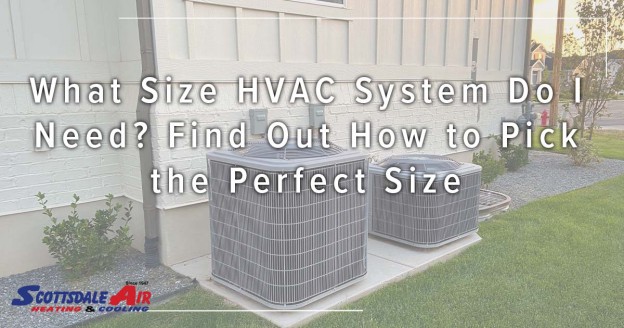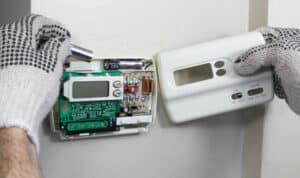Choosing the right size heating, ventilation, and air conditioning (HVAC) system for your home is a crucial decision. This system ensures your comfort in the cold winter and the hot summer, as well as affecting your energy bills, indoor air quality, and overall efficiency.
If you choose the wrong size HVAC system, you could end up with problems like inadequate heating and cooling, increased energy consumption, and a shorter lifespan for your equipment. To help you avoid these issues, the pros at Scottsdale Air put together a comprehensive guide to choosing the right size for your HVAC system and how to pick the perfect size.
The Importance of Choosing the Right Size HVAC System
Selecting the right size HVAC system is essential for multiple reasons, including:
-
- Efficiency: An appropriately sized HVAC system operates at peak efficiency. Oversized units may start and stop frequently, leading to inefficient energy usage and higher bills. Undersized units will struggle to maintain the optimal temperature, leading to longer running times and higher energy consumption.
- Comfort: An HVAC system that’s the right size for your home will provide consistent and comfortable temperatures throughout your living space. Undersized systems may not adequately heat or cool your home, while oversized systems can cause uncomfortable temperature swings.
- Energy costs: The size of your HVAC system directly affects your energy bills. A system that’s too big for your home will waste energy by consuming more than necessary, while an undersized system will run longer and take more wear and tear, driving up your energy costs.
- Longevity: An HVAC system that’s properly sized for your home will likely have a longer lifespan. Getting an oversized unit forces the system to cycle more often, leading to excess wear and tear. Undersized units have to work harder to keep your home warm or cool, causing it to break down sooner.
- Indoor air quality: HVAC systems are crucial to indoor air quality. They filter and dehumidify the air effectively. Oversized systems may not run long enough to adequately pull the humidity out, while undersized units may struggle to maintain good air quality.
- Environmental impact: An HVAC system that’s too large contributes to higher energy consumption and a larger carbon footprint. Selecting the right size system can help you reduce your environmental impact.
- Economic impact: Choosing the right HVAC system is a big financial investment for your home. A larger system will have higher upfront costs, often more than you need to spend, while undersized systems can cause you to have much higher operational expenses over the life of the system.
Factors That Influence HVAC System Sizing
Sizing an HVAC system isn’t a one-size-fits-all process. You need to consider multiple factors specific to your home and environment. Here are some things to consider:
-
- Climate: The local climate plays an important role in sizing your HVAC system. Regions that have extreme temperatures – either hot or cold – require more powerful systems to maintain comfort in your home. Scottsdale and the surrounding areas regularly hit temperatures in in the 90s, though the winters are often mild.
- Square footage: The size of your home is a critical factor in choosing the right HVAC system size. Larger homes need more heating and cooling capacity, while smaller homes can be served by smaller units.
- Insulation: The level and condition of the insulation in your home can dramatically affect the HVAC system size you need. Well-insulated homes retain heat or cool air more effectively, reducing the load on the HVAC system. If your home is poorly insulated, you may need a larger system to compensate for the heat loss or gain. It may be worth considering repairing the insulation prior to choosing an HVAC system.
- Windows and doors: The number, size, and type of windows and doors in your home affect heat gain and loss. Homes with large, poorly insulated windows or doors may need larger HVAC systems to offset heat transfer. Again, it may be best to upgrade your windows and doors, as well as their insulation, prior to choosing a system.
- Ceiling height: Homes with higher ceilings require more powerful HVAC systems to distribute conditioned air. The cubic footage of your living space, rather than just the square footage, should be considered.
- Direct sunlight: The direction your home faces and the amount of direct sunlight it receives can affect your HVAC system’s size. South-facing homes in the northern hemisphere receive more sunlight and may require larger cooling systems.
- Ductwork: The condition and design of your ductwork matter. Leaky or inefficient ducts can lead to energy loss, requiring a larger system to compensate. It’s best to properly seal and insulate your ducts before selecting a system.
- Occupancy and usage: The number of people in your home and how you use each room influence your HVAC needs. Homes with larger families or frequent guests may require more powerful systems.
- Appliances and electronics: The heat generated by appliances and electronics can add to your cooling load. Modern homes with numerous heat-producing devices may need larger HVAC systems.
- Future expansion: Consider your plans for your home’s expansion or renovation. If you have plans to add rooms to your home, it’s best to choose a system that is suited to your expanded living space.
How to Calculate HVAC System Size
Now that you know the factors that affect your HVAC system size, it’s time to explore the methods used to calculate it. There are two primary methods: the Manual J Load calculation and the Rule of Thumb method.

Manual J Load Calculation
The Manual J Load calculation is the industry standard for sizing HVAC systems. It’s precise and comprehensive approach that takes into account all the factors mentioned above. This method involves:
-
- Measuring and calculating the square footage, ceiling height, and insulation level of the home.
- Determining the heat gain and heat loss based on local climate data.
- Recording the size, type, and location of windows and doors and their U factors, which measures the rate of heat transfer
- Assessing the condition of the ductwork and considering factors like duct leakage and insulation quality.
- Calculating the heat output of appliances and electronics in the home.
- Considering the number of occupants and their activities, which generate heat.
- Using local weather data to determine the cooling and heating requirements for the region.
- Relying on specialized software to perform calculations accurately.
The Manual J Load calculation provides the most accurate estimate of the HVAC size to ensure it’s tailored to your home and needs.
Rule of Thumb
The Rule of Thumb method, as the name indicates, is a simplified and less accurate approach to estimating the HVAC system size based on general guidelines or “rule of thumb.”
The common rules of thumb include:
-
- Cooling: 20-25 British Thermal Units (BTU) per square foot
- Heating: 30-35 BTU per square foot
- One ton of cooling capacity for every 400-600 square feet
The Rule of Thumb method is quick and easy, but it can oversized HVAC systems and may not account for nuances of the home and climate.
The Manual J Load calculation is the recommended method for sizing HVAC systems, especially in situations when precision is important.
Why You Need a Professional HVAC Technician
While understanding the factors and methods for sizing your HVAC system is valuable, it’s best to seek the advice of a professional HVAC technician. They have the experience and knowledge to properly calculate the HVAC system you need and recommend the right size. They also consider factors like local building codes and standards, as well as the latest energy-efficient technologies.

Here are some other benefits of hiring a professional:
-
- Cost savings: The cost of hiring a professional is worth knowing you invested in the right system and that the job is done right the first time.
- Special training and knowledge: HVAC technicians routinely help homeowners select the right HVAC system for their homes, so they have more insights and knowledge to ensure you get the right system – something you can’t do on your own.
- A professional relationship: Once you work with an HVAC system to choose the right HVAC system, you already have a professional relationship for furnace installation in your home, and handling furnace repairs when the time comes.
- Safety: HVAC systems are complex and have a lot of moving parts. Trying to choose and install your own system is ill advised for several reasons, including safety hazards. A professional technician has the training and equipment necessary to do the job correctly and safely.
Get Your New HVAC System
Choosing the right size HVAC system for your home is a critical decision that impacts your comfort, energy bills, indoor air quality, and the environment. You have to consider a lot of different factors, including your home’s size, your climate, and the quality of the insulation and windows and doors. A professional HVAC contractor like Scottsdale Air can help you choose the ideal system for your needs and budget.
Ready to install your new system? Contact us at Scottsdale Air to schedule your appointment!





